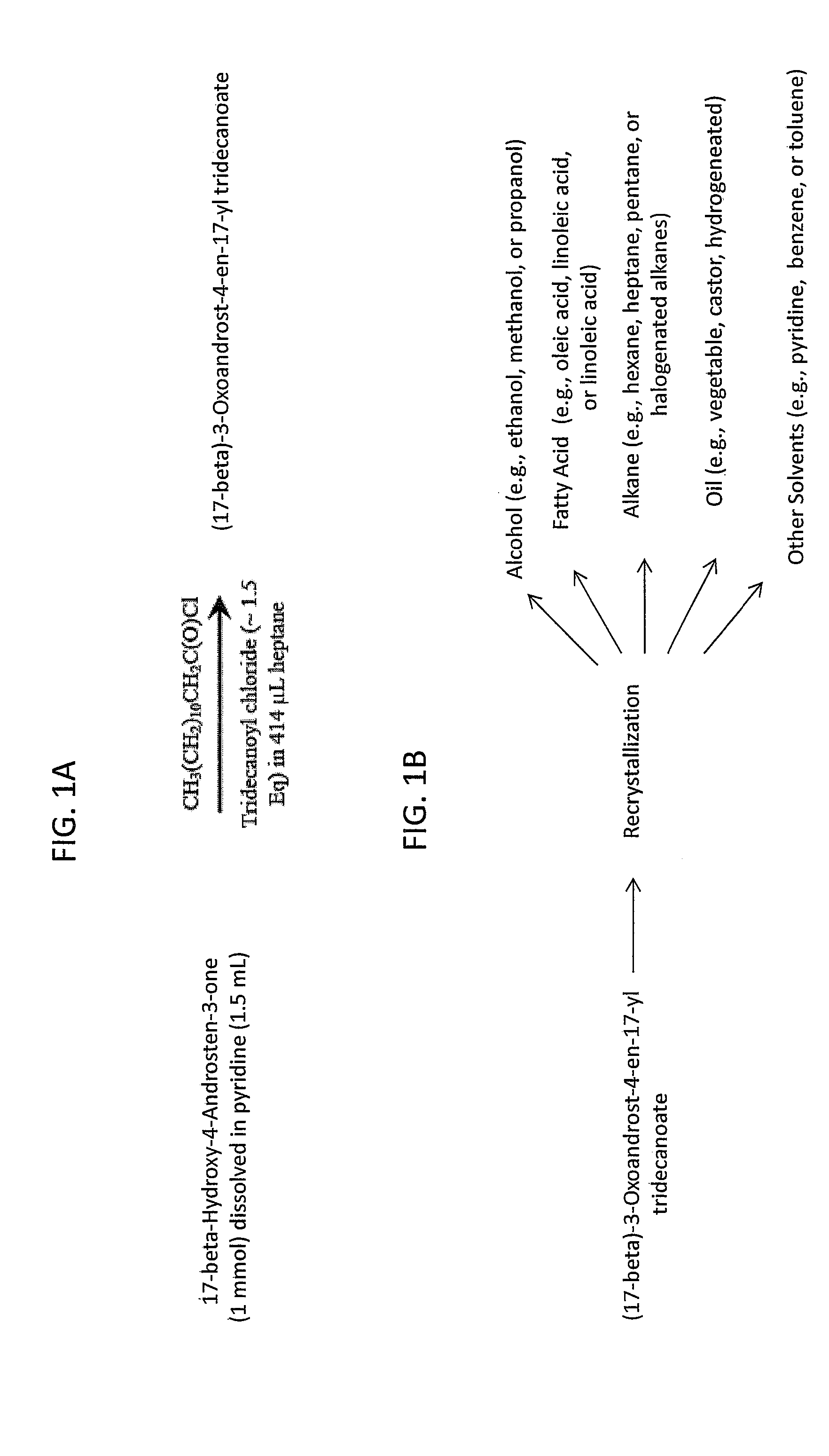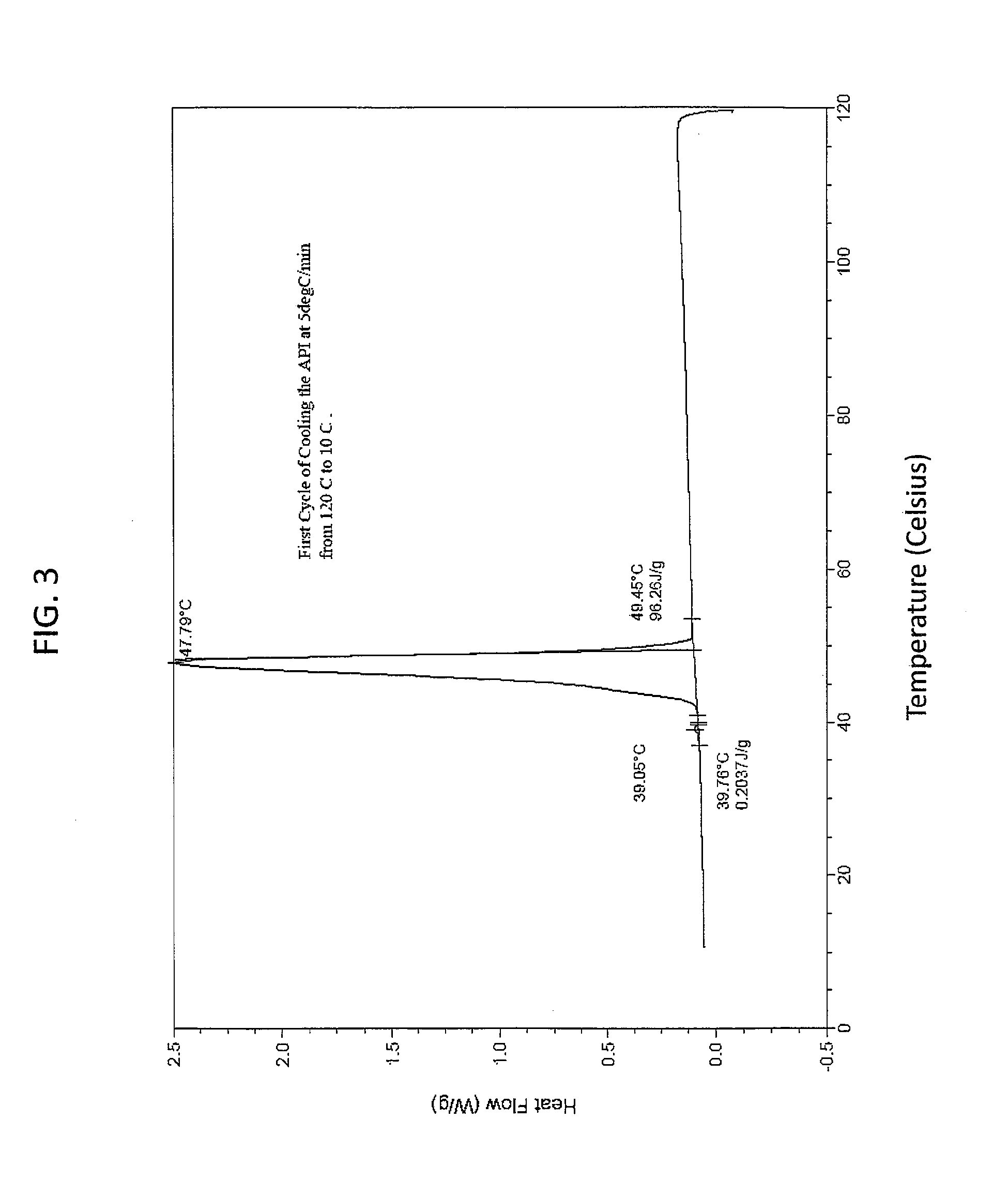Bioavailable solid state (17-β)-hydroxy-4-androsten-3-one esters
a technology of hydroxy-4 androstene, which is applied in the direction of antibody medical ingredients, organic active ingredients, pharmaceutical delivery mechanisms, etc., can solve the problems of not being adequately bioavailable, and achieve the effects of facilitating adequate partitioning, enhancing oral bioavailability, and adequate solubility
- Summary
- Abstract
- Description
- Claims
- Application Information
AI Technical Summary
Benefits of technology
Problems solved by technology
Method used
Image
Examples
example 1
Preparation of Solid State EAPI
[0129]A non-limiting exemplary synthetic scheme for producing a solid state ester of active pharmaceutical ingredient (EAPI) as disclosed herein is shown in FIG. 1A and is outlined in more detail below. The EAPI can be produced utilizing the generalized scheme set forth below:
[0130]1) (17-β)-Hydroxy-4-Androsten-3-one (0.1 mol) is weighed into a 1000 mL 4N RB flask containing a stir bar.
[0131]2) Pyridine (160 mL) is added to the flask.
[0132]3) The flask is placed in an ice-water bath and fitted with a nitrogen inlet, addition funnel, thermocouple, and stopper. Stirring and nitrogen flow are started.
[0133]4) The funnel is charged with a solution of acid chloride (1.56 equiv e.g., acid chloride of tridecanoic acid) in heptane (160 mL), then fitted with an adapter connected to a bubbler.
[0134]5) The contents of the funnel are added dropwise over 30-40 min (Note: the internal temperature increases 5-7° C. during the addition.)
[0135]6) When the addition is c...
example 2
Preparation of Solid State EAPI Crystals
[0138]A reaction mixture or product of Example 1 (or material produce by another route) can be transferred to water, ethanol, or methanol (or any other appropriate solvent) and allowed to crystallize. The crystalline mass can be filtered by suction, washed with water, dried over phosphorous pentoxide and re-crystallized from another solvent (although this step is not necessary) e.g., oleic acid, hexane, heptanes, etc. See FIG. 1B
example 3
Differential Scanning Calorimetry of Solid State EAPI
[0139]This example demonstrates that the solid state EAPI has a distinct melting point as determined using a differential scanning calorimeter. 5.9 mg of solid state EAPI (e.g., (17-β)-3-Oxoandrost-4-en-17-yl tridecanoate) was placed in the chamber of a DSC instrument and was heated from 10 to 120° C. The result is shown in FIG. 2, which shows a single peak at about 72.78° C. FIG. 3 shows the first cooling cycle with a single peak at about 47.79° C. The second heating run of this sample is show in FIG. 4 which shows a single peak at about 71.77° C. FIG. 5 shows the second cooling cycle with a single peak at about 46.46° C.
PUM
| Property | Measurement | Unit |
|---|---|---|
| particle size | aaaaa | aaaaa |
| particle size | aaaaa | aaaaa |
| particle size | aaaaa | aaaaa |
Abstract
Description
Claims
Application Information
 Login to View More
Login to View More - R&D
- Intellectual Property
- Life Sciences
- Materials
- Tech Scout
- Unparalleled Data Quality
- Higher Quality Content
- 60% Fewer Hallucinations
Browse by: Latest US Patents, China's latest patents, Technical Efficacy Thesaurus, Application Domain, Technology Topic, Popular Technical Reports.
© 2025 PatSnap. All rights reserved.Legal|Privacy policy|Modern Slavery Act Transparency Statement|Sitemap|About US| Contact US: help@patsnap.com



